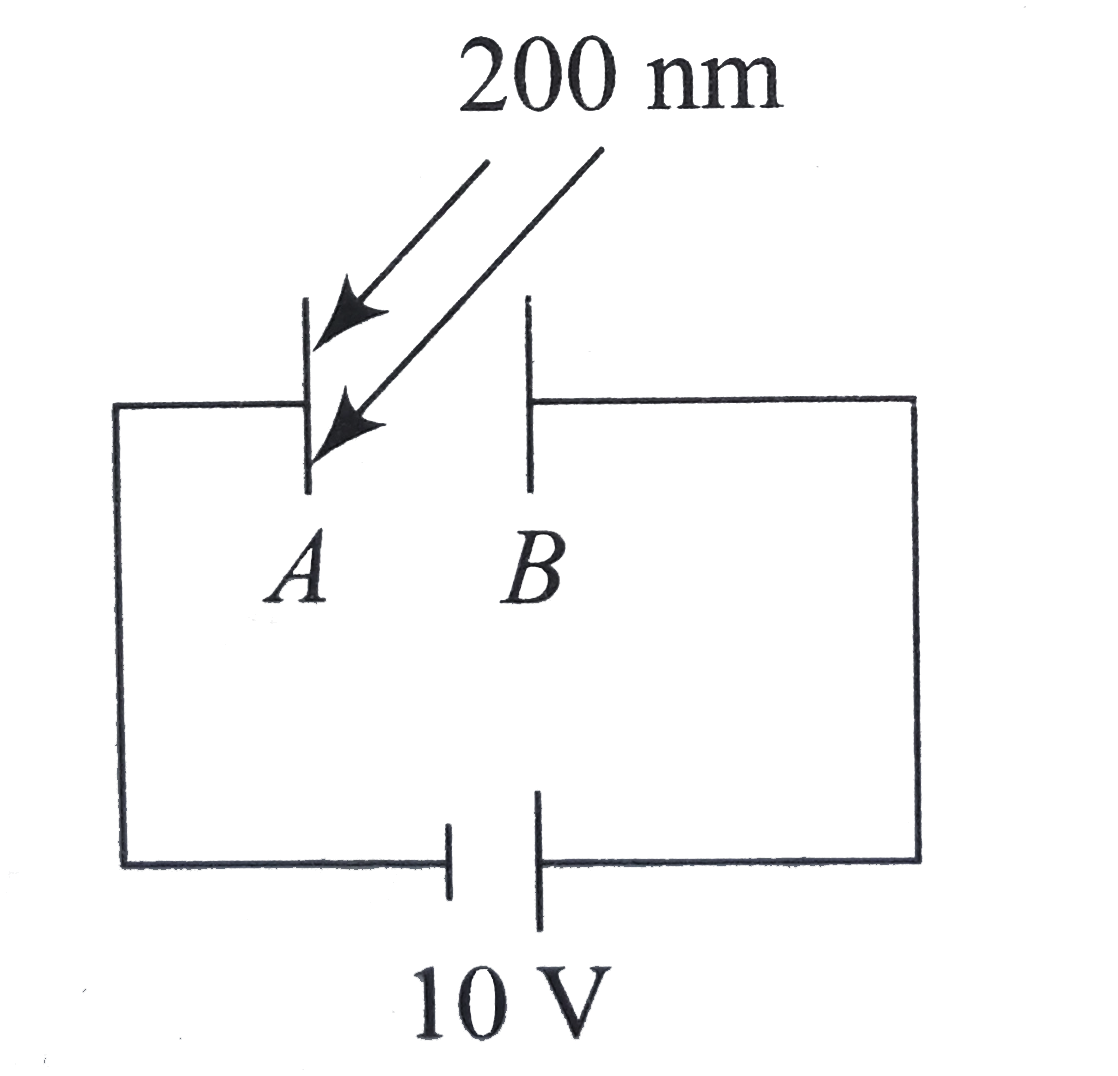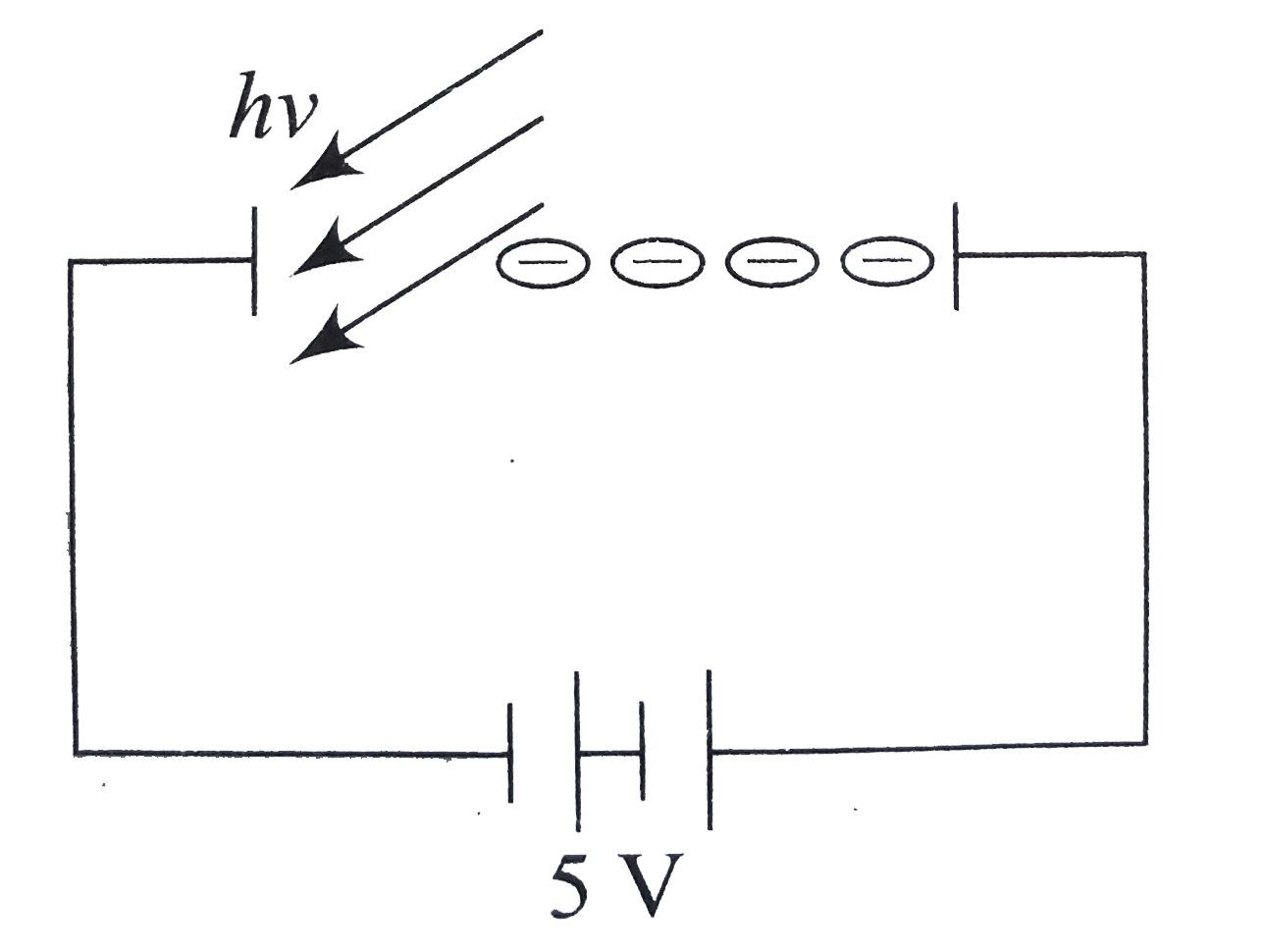Subjective from CENGAGE PHYSICS (ENGLISH) Chapter 20 PHOTOELECTRIC EFFECT for Class 12
| Class 12 | PHYSICS |
| Chapter | PHOTOELECTRIC EFFECT |
| CENGAGE PHYSICS (ENGLISH) | Subjective |
| Medium | English |
| Academic Year | 2023-2024 |
Question 1

In Fig. electromagnetic radiations of wavelength 200nm are incident on a metallic plate A. the photoelectrons are accelerated by a potential difference of 10 V. These electrons strike another metal plate B from which electromagnetic radiations are emitted. The minimum wavelength of emitted photons is 100nm. If the work function of metal A is found to be (×x10−1)ev, then find the value of x. (Given hc=1240eV nm) View SolutionQuestion 2
The path of photoelectrons emitted due to electromagnetic radiation incident on a sample of material A, is found to have a maximum bending radius of 0.1 m in a magnetic field of (√23)×10−4T. When the radiation is incident normally on a double slit having a slit separation of 0.1mm, it is observed that there are 10 fringes in a width of 3.1 cm on a screen placed at a distance of 1 m from the double slit. Find the work function of the material. and the corresponding threshold wavelength. What sould be the wavelength of the incident light so that the bending radius is one-half of what it was before? Given that mass of the electron=0.5MeVc2,hc=12400eV−AView SolutionQuestion 5
Light of wavelength 180 nm ejects photoelectrons from a plate of metal whose work - function is 2 eV. If a uniform magnetic field of 5×10−5 T be applied parallel to the plate, what would be the radius of the path followed by electrons ejected normally from the plate with maximum energy.View SolutionQuestion 6
When a surface is irradiated with light of wavelength 4950A, a photocurrent appears which vanishes if a retarding potential greater than 0.6V is applied across the photo tube. When a different source of light is used, it is found that the critical retarding potential is changed to 1.1V. Find the work function of the emitting surface and the wavelength of the second source.View SolutionQuestion 8
A vacuum photocell consists of a central cathode and an anode. The internal surface is silver of work function 4.5 eV. The contact potential difference between the electrodes equals to 0.6 V. The photocell is illuminated by light of wavelength 2.3×10−7m.
a. What retrading potential difference should be applied between electrodes of the photocell for the photocurrent to drop to zero?
b. If a retarding potential of 1V is applied between electrodes at what limiting wavelength λ of light incident on the cathode will on the cathode will the photoelectric effect begin?View SolutionQuestion 9
The rediation emitted when an electron jumps from n=3→n=2 orbit in a hydrogen atom falls on a metal to produce photoelectron. The electron from the metal surface with maximum kinetic energy are made to move perpendicular to a magnetic field of (1/320)T in a radius of 10−3m. Find (a) the kinetic energy of the electrons, (b) Work function of the metal , and (c) wavelength of radiation.View SolutionQuestion 10
A parellel beam of monochromatic light of wavelength 500 nm is incident normally on a perfectly absorbing surface. The power through any cross section of the beam is 10 W. Find
(a) the number of photons absorbed per second by the surface and
(b) the force exerted by the light beam on the surface.View SolutionQuestion 11
A uniform monochromatic beam of light of wavelength 365×10−9m and intensity 10−8Wm−2 falls on a surface having absorption coefficient 0.8 and work function 1.6 eV. Determine the number of electrons emitted per square metre per second, power absorbed per m2, and the maximum kinetic energy of emitted photo electrons.View SolutionQuestion 13
What amount of energy sould be added to an electron to reduce its de Broglie wavelength λ1=550nm incident on it, causing the ejection of photoelectrons for which the stopping potential is Vs1=0.19V. If the radiation of wavelength λ2=190nm is now incident on the surface, (a) calculate the stopping potential VS2, (b) the work function of the surface, and (c) the threshold frequency for the surface.View SolutionQuestion 14
What amount of energy should be added to an electron to reduce its de Broglie wavelength λ1=550nm incident on it, causing the ejection of photo-electrons for which the stopping potential is Vs1=0.19V. If the radiation of wavelength λ2=190nm is now incident on the surface, (a) calculate the stopping potential VS2, (b) the work function of the surface, and (c) the threshold frequency for the surface.View SolutionQuestion 15
A cylindrical rod of some laser material 5×10−2m long and 10−2m in diameter contains 2×1025 ions per m3. If on excitation all the ions are in the upper energy level and de-excite simultaneously emitting photons in the same direction , calculate the maximum energy contained in a polse of radiation of wavlength 6.6×10−7m. If the pulse lasts for 10−7s, calculate the average power of the laser during the pulse.View SolutionQuestion 16
A 100 W sodium lamp is radiating light of wavelength 5890A, uniformly in all directions,
a. At what rate, photons are emitted from the lamp?
b. At what distance from the lamp, the average flux is 1 photon(cm2−s)−1?
c. What are the photon flux and photon density at 2m from the lamp?View Solution
